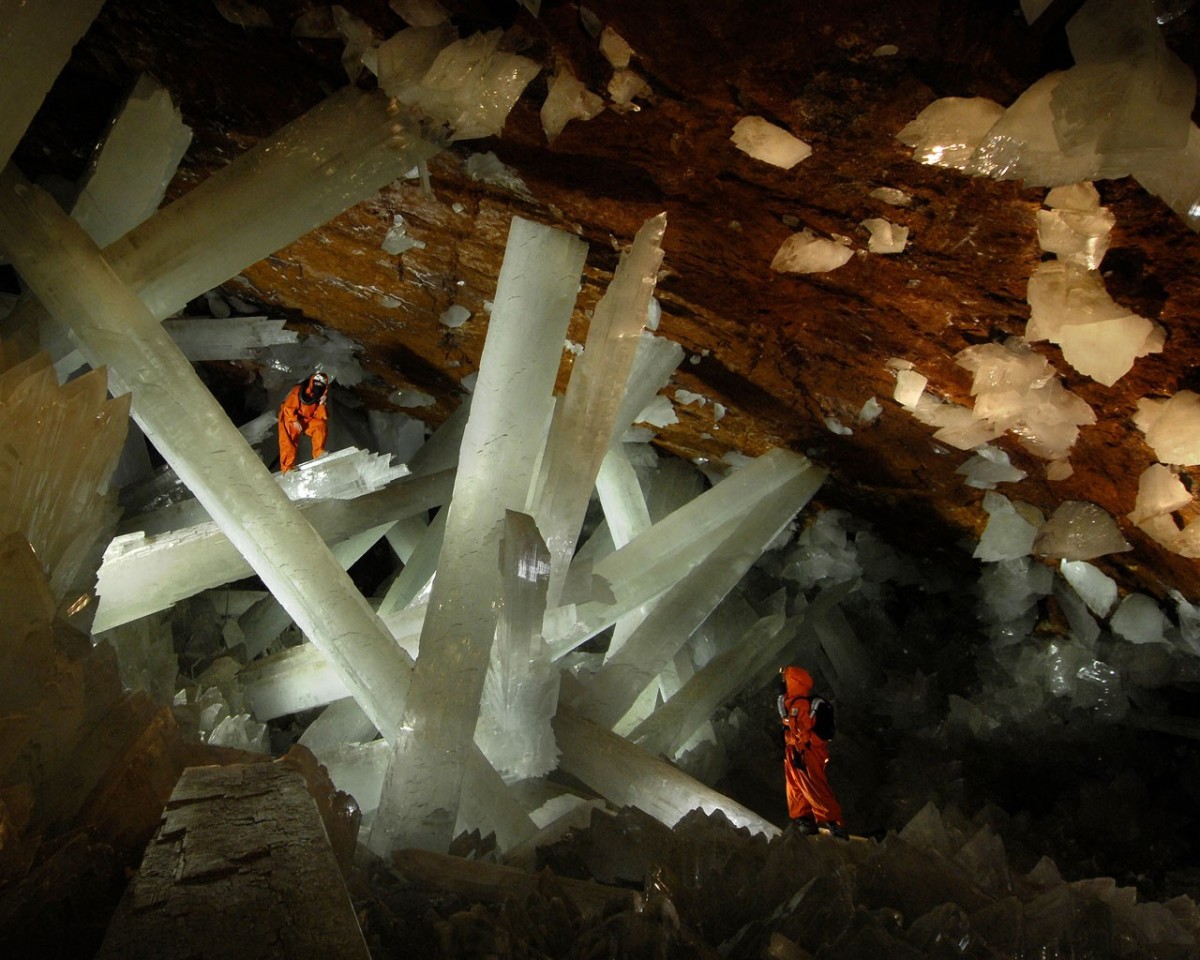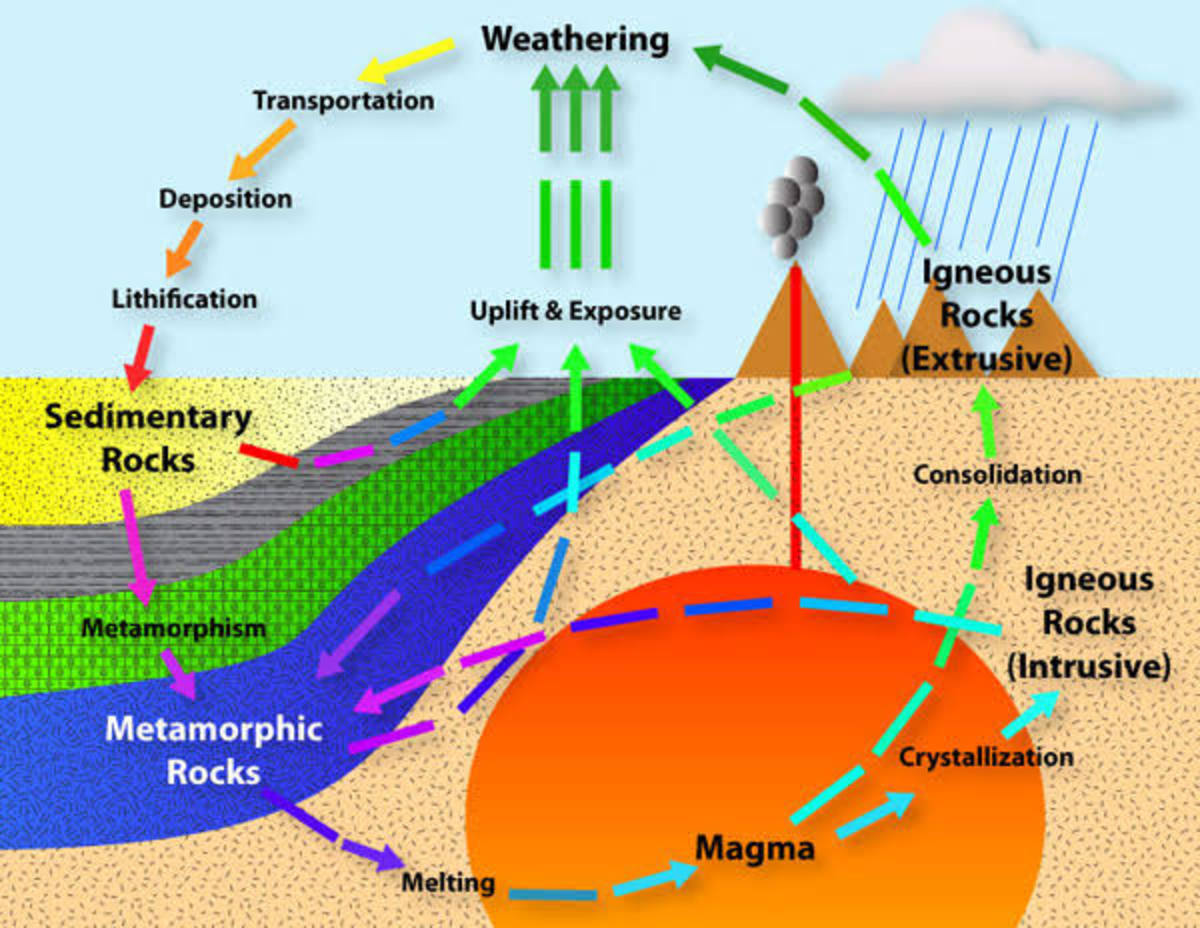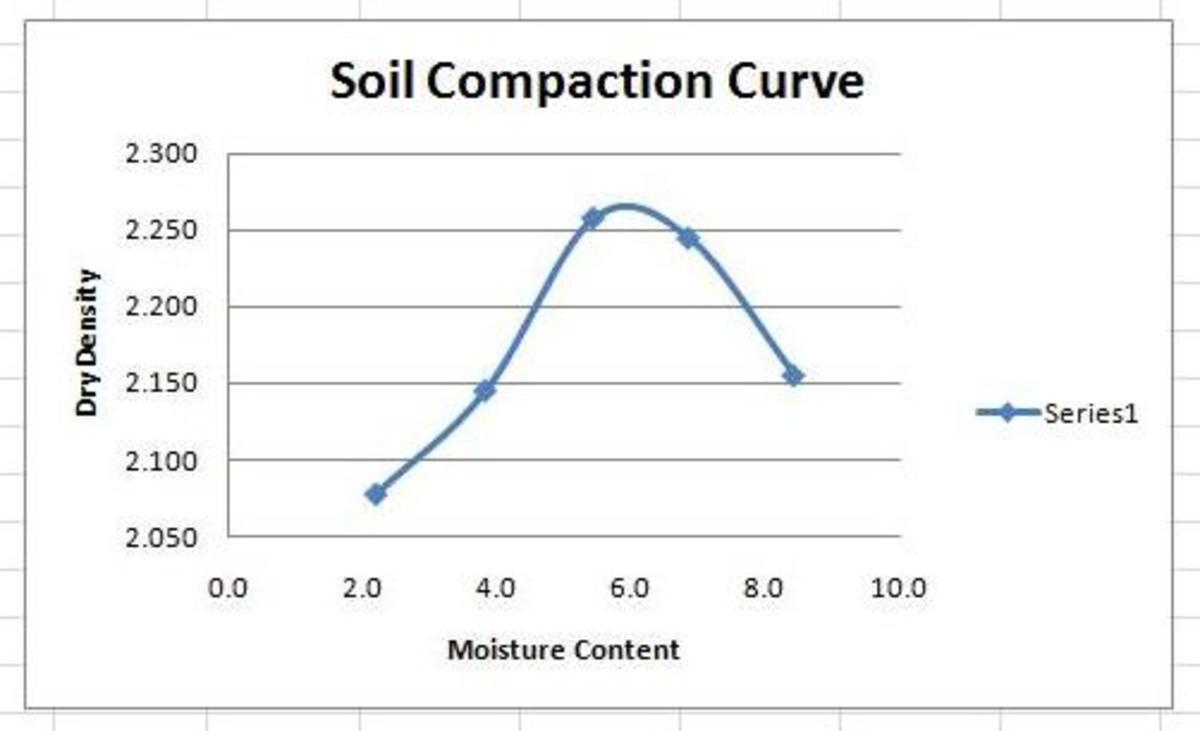The Greatest Scientists of all Time : James Hutton - Founder of Modern Geology
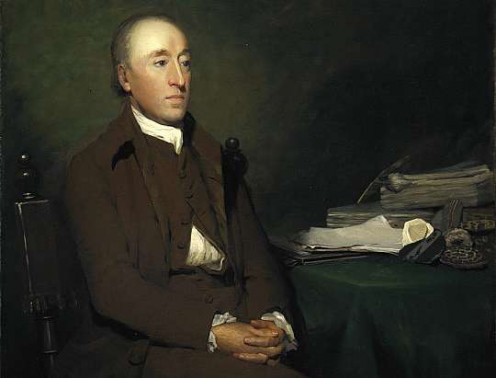
The Greatest Scientists of all Time : James Hutton - Founder of Modern Geology
You can learn a lot from a farmer. You can especially learn a lot about the land from a farmer. Since they work it almost everyday this should not be a surprise.
What might surprise you to learn is that one such farmer founded the science of modern Geology as we know it today.
His name was James Hutton and back in 18th century Scotland he revolutionised how we thought about the world and how our planet developed through the ages. However James Hutton was more than just a farmer as he had many talents at his disposal.
He was born in 1726 in Edinburgh and was one of five children. His father was a merchant and City Treasurer but unfortunately died when James was young. His mother sent him to the High School in Edinburgh were he showed an early interest in Chemistry and Mathematics.
The young academic
Nevertheless at University from aged 14 he studied the Classics and then trained as a lawyer. But he was more interested in the sciences and became a Physicians Assistant and also attended Medical lectures at Edinburgh University. However the main reason that he decided to study medicine was because it was the closest discipline to his first love of Chemistry.
He then travelled to continue his studies in Europe. This may have been due to the fact that he fathered an illegitimate child to a woman in Edinburgh. He therefore studied Medicine at the University of Paris and then completed his Doctorate at Leyden in Holland in 1749. He would have finished his studies earlier if it had not been for the intrusion of the 1745 Jacobite Rebellion which put academic life in Edinburgh on hold for a year. Even his former tutor Colin Maclaurin was involved in preparing the defence of the capital city. He was the famous scholar after which are named the Maclaurin Mathematical series of functions.
The farmer's life
Unfortunately Hutton struggled to get employment in the medical profession. However he had many talents and this did not stop his progress. Along with his friend James Davie he discovered how to make 'sal ammoniac' a chemical substance that could be used in welding metal. They subsequently founded a successful chemical works that ensured a more than healthy income for Hutton.
In 1754 he took control of two farms inherited from his late father and ran them for the next 14 years. These were situated in Berwickshire and Hutton threw himself into working as a farmer. He went to Norfolk to learn practical farming techniques and also his travels in Holland, Belgium and Northern France taught him more about working the land.
In Berwickshire he introduced improved methods of husbandry but also studied the terrrain especially the rocks on the coastline at Siccar Point. He eventually grew bored with this lifestyle as it had become less challenging and he hungered to pursue his studies of the earth. He wanted to fully devote himself to research and since he possessed significant wealth he had the time and resources to conduct such studies. His quest was to trace the origins of the Earth's multitude of minerals and rocks.
A capital return
Therefore he returned to Edinburgh in 1767 after renting out the farms to tenants and moved into a new-built house in St John's Hill in the city. He lived with his three sisters and never actually married as he was apparently unlucky in love. A famous quote made by him on his personal life was revealing as it was a sad commentary;
"O if the ladies were but capable of loving us men with half the affection that I have towards the cows and calves that happen to be under my nurture and admonition what a happy world we would have"
All his energies it seemed were directed towards his obsession with rocks and minerals. And it was appropriate that the new house had a view of the nearby Salisbury Crags that tower over the east side of the city. For it was there on the crags that he gathered more evidence to support his theories.
The Salisbury Crags today
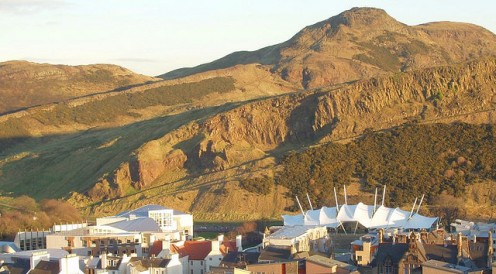
Hutton's Unconformity
The Salisbury Crags are a volcanic sill made of igneous basalt rock and date from the Carboniferous Period since they are around 340 million years old. However there are obviously different types of rock covering the surface of the earth and they are often created by different forces.
Igneous rock is formed from melted rock such as magma or lava whereas sedimentary rock consists of particles accumulated, settled by water and fused by heat thereby forming the 'sediment' as such. However igneous rock is much harder than sedimentary. Hutton came up with the hypothesis that this igneous rock 'intruded' upwards into sedimentary rock. This idea posited the thrust of molten rock into gaps in the strata of the earth's surface.
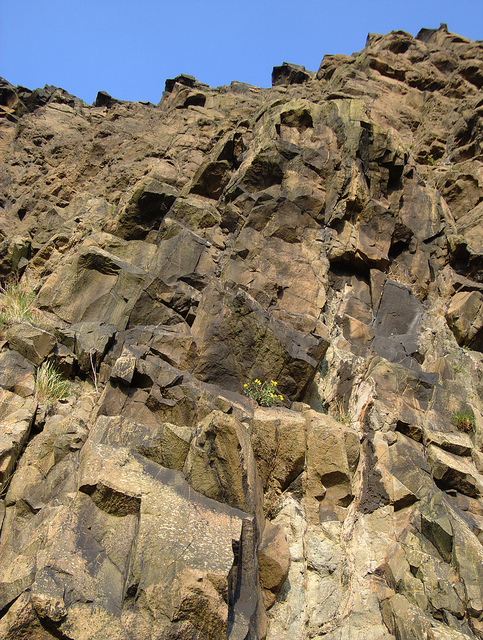
Hutton concluded that the extreme heat that fused sedimentary rock must also be able to create an;
"expansive force, sufficient for elevating the land from the bottom of the ocean to the place it now occupies"
Central to this thesis was the fact that he discovered channels of minerals that contained matter unrelated to the strata that they intruded through.
Not only were they foreign substances but that also the angles of layering of older rock could vary from the horizontal.
In fact they could run vertically which led Hutton to conclude that heat had forced molten rock upwards and tilted and deformed the older rock.
This was called an 'unconformity' as these layers of younger rock caused a break in the sedimentary evolution of strata. In other words Hutton discovered the phenomenon that there were actually younger rocks lying horizontally above older vertical rock strata.
The Theory of the Earth and Uniformitarianism
From these many years of observation and theorising Hutton presented his views to the Royal Society of Edinburgh in 1785 with his paper 'Theory of the Earth'. His findings were summarised with the following;
- Contemporary rock formations were formed from the waste of older rocks
- These older rocks were consolidated under extreme pressure
- These rocks were then disrupted and fissures created by the expansion cause by subterranean heat forces
- During these eruptions molten rock was injected into the fissures
- The disturbed and subsequently uplifted rock formations decay and erode when exposed to the atmosphere
- This decay will continue until the formations are worn away and settle on the sea-bed
He stated that this process is repeated over aeons and that it is cyclical in nature. This is called the 'Theory of Uniformitarianism' that stipulates that natural laws that exist today have always existed here on Earth and elsewhere in the Universe. In his own words;
"The present is the key to the past"
What Hutton had realised was that for this phenomenon to occur then the Earth must be ancient in origin. It is the time gaps and the unimaginably slow process of Unconformity that told him that the earth must be much older than the 6,000 years as deduced by scholars of the bible.
Hutton displayed that the surface of Planet Earth was in a continuous state of change and metamorphosis. It was constantly being recycled and then regenerated from the immense power of the heat underneath.
He actually surmised that the age of the planet was infinite going back into limitless time.
Of course modern science tells us that the age of the earth is 4.5 billion years. However that presumably would have seemed an infinite time for an amateur 18th century enthusiast like Hutton with no recourse to carbon dating.
But scientists rarely operate in a vacuum and before Hutton there were already people studying Mineralogy. In fact the work of some Italian researchers anticipated his ideas on Unconformity but he deserves the utmost credit for understanding the relations between different types of rock formations in the process of change and regeneration.
John Playfair
It is perhaps no coincidence that Hutton was friends with his contemporaries Joseph Black and James Watt. The former who discovered carbon dioxide and the latter who revolutionised steam technology which undoubtedly influenced his thinking. Hutton lived during the Scottish Enlightenment when men of ideas and foresight were many in number. Edinburgh was later described as a 'Hotbed of Genius' by writer David Daiches in reference to great men like Hutton and his ilk.
On the other hand another friend who more than influenced Hutton's reputation was John Playfair who was a scientist and mathematician. Besides his scientific prowess Playfair was also a gifted writer. Unfortunately the polymathic abilities of James Hutton fell short when it came to writing about his theories and research. Consequently readers found his publications obscure and difficult to understand. Therefore upon his death in 1797 he had perhaps not achieved the fame that his work should surely have warranted.
However Playfair published the book 'Illustrations of the Huttonian Theory of the Earth' in 1802 to much acclaim. His succint and lucid style of prose succeeded more than any of Hutton's own words to publicise the research. Playfair became an effective conduit for Hutton's ideas and observations and opened them up to a wider audience. This eventually established his well-deserved reputation as the gifted amateur who became the founding father of the modern science of Geology.
Incidentally, Hutton also theorised on the process of natural selection many years before Charles Darwin. Although Darwin also studied Medicine for a time at the University of Edinburgh there is no evidence that he knew of Hutton's writings and his work on 'On the Origin of Species' developed independently in the 19th century.
As highlighted by Playfair in the 1802 book, Hutton wrote about;
"...those organised bodies, which most approach to the best constitution for the present circumstances, will be best adapted to continue, in preserving and multiplying the individuals of their race"
Hutton's mind it seemed was as rich, varied and fertile as the land that he studied in such depth. A land of course to which he was returned upon his death and he is buried in the churchyard of the famous Greyfriars Kirk in Edinburgh. Given his anonymity amongst the wider public it may be apposite that his grave was unmarked.
However in 1947 a memorial tablet in the graveyard was unveiled as a lasting legacy to his life and work. Subsequently a memorial garden was also opened in his honour in 2002 on the site of his old house in St John's Hill. It contains a large rock inscribed with the words:
"We find no vestige of a beginning, no prospect of an end".
Undoubtedly a fitting tribute to a man of the soil.
______________________________________________
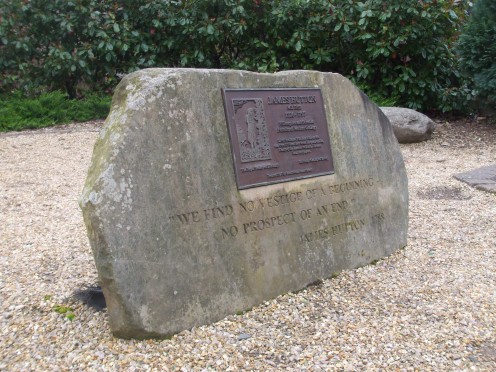
Read about other Famous Scots at these Shinkicker Hubs
- World Famous Explorers : "Doctor Livingstone, I Presume?"
In an ever-shrinking modern world it is perhaps hard to imagine the notion of uncharted territory. But less than 200 years ago a young Scotsman set out into what was then called 'Darkest Africa' to discover new lands and their hidden people. - The Greatest Scientists of All Time : Sir James Clerk Maxwell
Perhaps not a name that immediately springs to mind among the general public concerning the arbitrary notion of who are the greatest scientists of all time. But 19th century scientist Sir James Clerk Maxwell helped change the world. - Famous Doctors in History : Sir James Young Simpson
The next time you experience the relief of a pain-killing treatment or injection you may want to give praise to the people who made that possible. And think of a great Scotsman who lived back in the 19th century.





